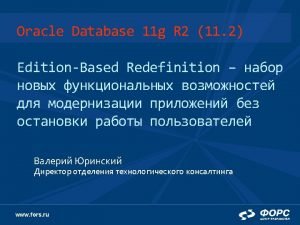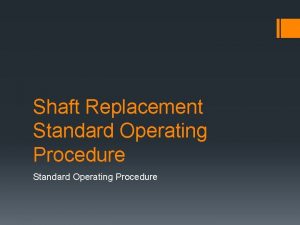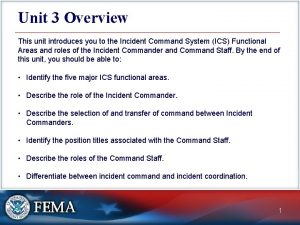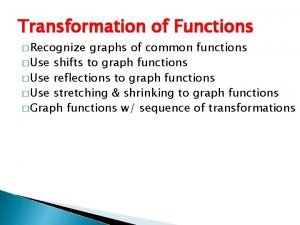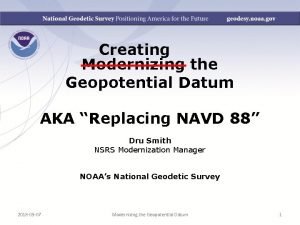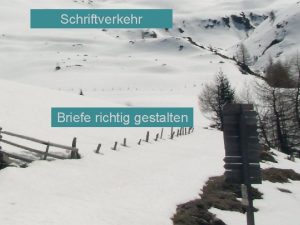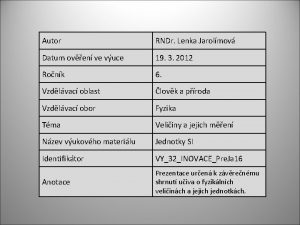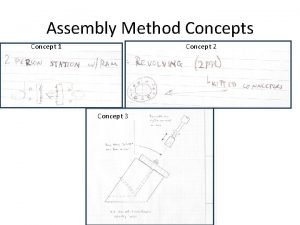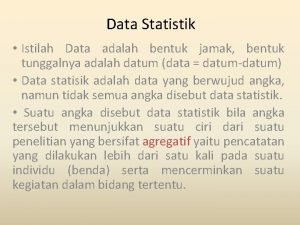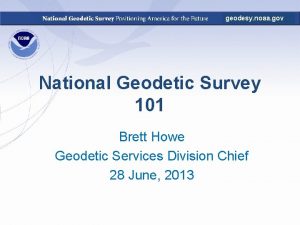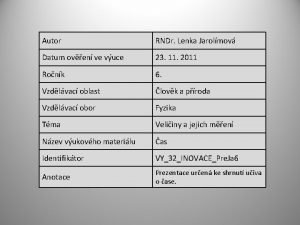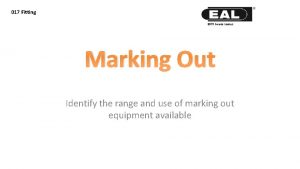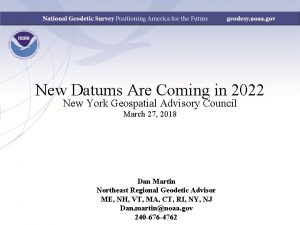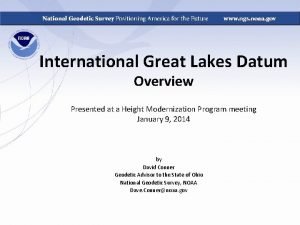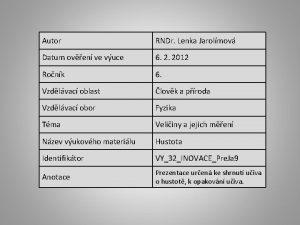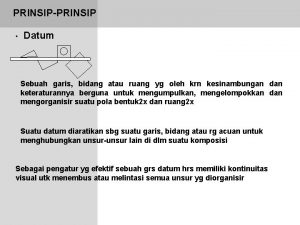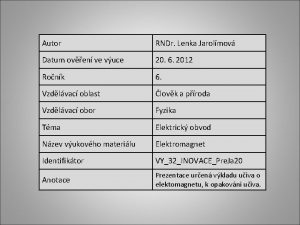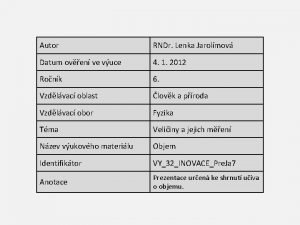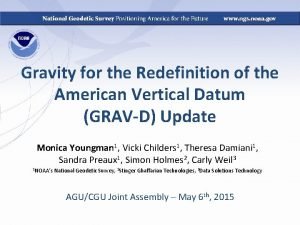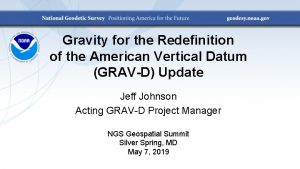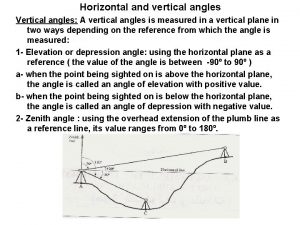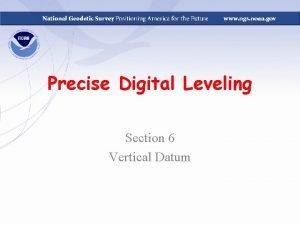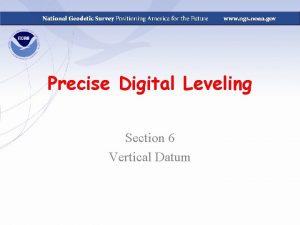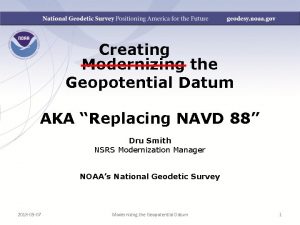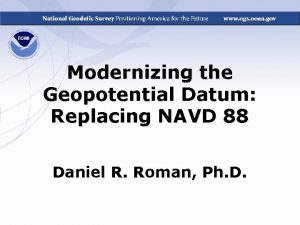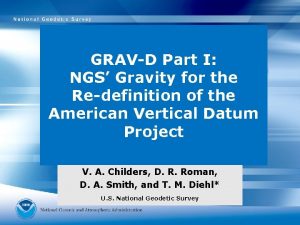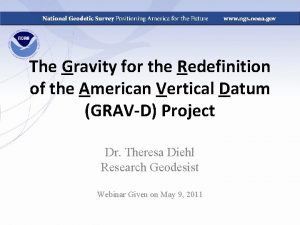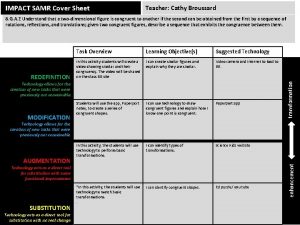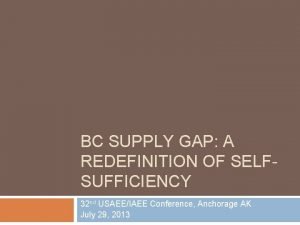Redefinition of the U S Vertical Datum Replacing























































- Slides: 55

Redefinition of the U. S. Vertical Datum: Replacing NAVD 88 Informational packet including GRAV-D updates Last Updated 12 October 2010 (DAS) 1

Outline • • • What is a vertical datum (3 slides)? NGS’s role and authority vis-a-vis “vertical datums” (5 slides) History of vertical datums in the USA (5 slides) Why isn’t NAVD 88 good enough anymore? (4 slides) Possible ways to fix NAVD 88 (6 slides) What is GRAV-D? (6 slides) Why GRAV-D? (4 slides) What’s the status of GRAV-D? (8 slides) How will I access the new vertical datum? (10 slides) Additional Information (2 slides) Last Updated 12 October 2010 (DAS) 2

What is a vertical datum (1 of 3)? • Many variations of the definition exist • Strictly speaking, a vertical datum is: – A surface representing zero elevation • Traditionally, a vertical datum has been thought of in a more broad sense: – A system for the determination of heights above a zero elevation surface Last Updated 12 October 2010 (DAS) 3

What is a vertical datum (2 of 3)? • A vertical datum always has two components: – Its definition • Parameters and other descriptors – Its realization • Its physical method of accessibility Last Updated 12 October 2010 (DAS) 4

What is a vertical datum (3 of 3)? • Example: North American Vertical Datum of 1988 (NAVD 88) • Definition: The surface of equal gravity potential to which orthometric heights shall refer in North America*, and which is 6. 271 meters (along the plumb line) below the geodetic mark at “Father Point/Rimouski” (NGSIDB PID TY 5255). • Realization: Over 500, 000 geodetic marks across North America with published Helmert orthometric heights, most of which were originally computed from a minimally constrained adjustment of leveling and gravity data, holding the geopotential value at “Father Point/Rimouski” Last Updated 12 October 2010 (DAS) fixed. 5

NGS’s role and authority vis-a-vis “vertical datums” (1 of 5) • Coast and Geodetic Survey Act (Public Law 80 -373) gives the Department of Commerce the right to (amongst numerous other things): – “…conduct …geodetic control surveys…” • http: //uscode. house. gov/download/pls/33 C 17. txt Last Updated 12 October 2010 (DAS) 6

NGS’s role and authority vis-a-vis “vertical datums” (2 of 5) • OMB Circular A-16 (revised): • Names DOC and NOAA as “lead agency” for Geodetic Control, and says: • “All NSDI framework data and users' applications data require geodetic control to accurately register spatial data. ” • “The National Spatial Reference System is the fundamental geodetic control for the United States. ” Last Updated 12 October 2010 (DAS) 7

NGS’s role and authority vis-a-vis “vertical datums” (3 of 5) • OMB Circular A-16 (revised): • Because NGS is the only agency inside DOC or NOAA that sets geodetic control, the NSRS responsibility falls to NGS. The NGS mission reflects this OMB-granted responsibility: – NGS Mission: “To define, maintain, and provide access to the National Spatial Reference System to meet our nation’s economic, social, and environmental needs” • www. whitehouse. gov/omb/Circulars/a 016_rev. html Last Updated 12 October 2010 (DAS) 8

NGS’s role and authority vis-a-vis “vertical datums” (4 of 5) • FGCS Federal Register Notice (Vol. 58, No. 120) • Affirms “NAVD 88 as the official civilian vertical datum for surveying and mapping activities in the United States performed or financed by the Federal Government. • “To the extent practicable, legally allowable, and feasible, require that all Federal agencies using or producing vertical height information undertake an orderly transition to NAVD 88. ” • http: //www. ngs. noaa. gov/PUBS_LIB/Fed. Register/FRdoc 93 -14922. pdf Last Updated 12 October 2010 (DAS) 9

NGS’s role and authority vis-a-vis “vertical datums” (5 of 5) • Summary: – OMB A-16 establishes DOC/NOAA (implying NGS) as lead agency for NSDI geodetic control (the NSRS) – NGS has defined the vertical datum portion of the NSRS as NAVD 88 – FGCS requires that all civilian federal surveying and mapping that uses heights be in NAVD 88 • These regulations do not apply to Do. D nor to state and local surveying, but these groups often do adopt Last Updated 12 October 2010 (DAS) NAVD 88 10

History of vertical datums in the USA (1 of 5) • Pre-National Geodetic Vertical Datum of 1929 (NGVD 29) – The first geodetic leveling project in the United States was surveyed by the Coast Survey from 1856 to 1857. – General adjustments of leveling data yielded datums in 1900, 1903, 1907, and 1912. – NGS does not offer products which transform from these older datums into newer ones (though some users still work in them!) Last Updated 12 October 2010 (DAS) 11

History of vertical datums in the USA (2 of 5) • NGVD 29 – National Geodetic Vertical Datum of 1929 – Original name: “Sea Level Datum of 1929” – “Zero height” held fixed at 26 tide gauges – Did not account for Local Mean Sea Level variations from the geoid • Thus, not truly a “geoid based” datum Last Updated 12 October 2010 (DAS) 12

History of vertical datums in the USA (3 of 5) • NAVD 88 – North American Vertical Datum of 1988 – One height held fixed at “Father Point” (Rimouski, Canada) – …height chosen was to minimize 1929/1988 differences in USGS maps – Thus, the “zero height surface” of NAVD 88 wasn’t chosen for its closeness to the geoid (but it was close…few decimeters) Last Updated 12 October 2010 (DAS) 13

History of vertical datums in the USA (4 of 5) • NAVD 88 (continued) – Use of one fixed height removed local sea level variation problem of NGVD 29 – Use of one fixed height did open the possibility of unconstrained cross-continent error build up – But the H=0 surface of NAVD 88 was supposed to be parallel to the geoid…(close again) Last Updated 12 October 2010 (DAS) 14

History of vertical datums in the USA (5 of 5) • NAVD 88 (continued) – Defined only on the conterminous North American Continent – Does not (and can not) exist for any place you can’t level to from Father Point, such as: • Guam, American Samoa, Hawaii, Puerto Rico, American Virgin Islands, Commonwealth of the Northern Marianas, Aleutian Islands Last Updated 12 October 2010 (DAS) 15

Why isn’t NAVD 88 good enough anymore? (1 of 4) • NAVD 88 suffers from use of bench marks that: – Are almost never re-checked for movement – Disappear by the thousands every year – Are not funded for replacement – Are not necessarily in convenient places – Don’t exist in most of Alaska – Weren’t adopted in Canada – Were determined by leveling from a single point, allowing cross-country error build up Last Updated 12 October 2010 (DAS) 16

Why isn’t NAVD 88 good enough anymore? (2 of 4) • NAVD 88 suffers from: • A zero height surface that: – Has been proven to be ~50 cm biased from the latest, best geoid models (GRACE satellite) – Has been proven to be ~ 1 meter tilted across CONUS (again, based on the independently computed geoid from the GRACE satellite) Last Updated 12 October 2010 (DAS) 17

Why isn’t NAVD 88 good enough anymore? (3 of 4) Earth’s Surface H (NAVD 88) H ce level n 8 refere NAVD 8 The Geoid Errors in NAVD 88 : ~50 cm average, 100 cm CONUS tilt, 1 -2 meters average in Alaska NO tracking Last Updated 12 October 2010 (DAS) 18

Why isn’t NAVD 88 good enough anymore? (4 of 4) • Approximate level of geoid mismatch known to exist in the NAVD 88 zero surface: Last Updated 12 October 2010 (DAS) 19

Possible ways to fix NAVD 88 (1 of 6) • Short term fixes: – Provide fast methods of expanding NAVD 88 in areas where it is needed • Long term fixes: – Re-level some / all of NAVD 88 – Replace NAVD 88 bench marks Last Updated 12 October 2010 (DAS) 20

Possible ways to fix NAVD 88 (2 of 6) • Short term fix: Height Modernization GPS surveys – Have provided a fast way to disseminate NAVD 88 bench mark heights to new marks through the use GPS and a constrained least squares adjustment – NOAA TM NOS NGS 58 and 59 guidelines – Keeps NAVD 88 useful and accessible, but does not address the majority of problems of NAVD 88 itself Last Updated 12 October 2010 (DAS) 21

Possible ways to fix NAVD 88 (3 of 6) • Long term fix: Re-level some/all of NAVD 88 • Re-leveling NAVD 88 would cost between $200 Million and $2 Billion • This wouldn’t fix all of the problems associated with the use of bench marks though Last Updated 12 October 2010 (DAS) 22

Possible ways to fix NAVD 88 (4 of 6) • Long term fix: Replace NAVD 88 • Find a method of defining a vertical datum that seeks to fix all of the known issues with NAVD 88 • Best option: Define the datum as a given geoid model and realize it through GNSS technology – GRAV-D Last Updated 12 October 2010 (DAS) 23

Possible ways to fix NAVD 88 (5 of 6) • Long term fix: Replace NAVD 88 (continued) • GRAV-D Trade-offs: Datum is only realizable to 2 cm at best at any given point (GNSS error + geoid error) – However, this is an improvement over NAVD 88 realization error – The datum could then be disseminated locally through very precise geodetic leveling Last Updated 12 October 2010 (DAS) 24

Possible ways to fix NAVD 88 (6 of 6) • Long term fix: Replace NAVD 88 (continued) • GRAV-D International Issues – Canada has agreed to move to a geoid based vertical datum • Negotiations with USA underway – Mexico has no plans yet to move to a geoid based datum – Central American, Caribbean: No policy to switch, but the datum will be freely available to them Last Updated 12 October 2010 (DAS) 25

What is GRAV-D? (1 of 6) • Gravity for the Redefinition of the American* Vertical Datum • An NGS project whose target is to redefine the official civilian vertical datum as the geoid, realized through the use of GNSS technology and a gravimetric geoid model over at least the United States and its territories Last Updated 12 October 2010 (DAS) 26

What is GRAV-D? (2 of 6) • Official NGS policy as of Nov 14, 2007 • Airborne Gravity Snapshot • Absolute Gravity Tracking • Re-define the Vertical Datum of the USA by 2022 (at current funding levels) • Part of the NGS 10 year plan (20082018) • Target: 2 cm accuracy orthometric heights from GNSS and a geoid model Last Updated 12 October 2010 (DAS) 27

What is GRAV-D? (3 of 6) • GRAV-D means fast, accurate, consistent orthometric heights everywhere in the USA • GPS already gives fast accurate ellipsoid heights • If the geoid were modeled (and monitored) to highest accuracy…fast, accurate orthometric heights, anywhere, anytime • No need to use leveling to “bring in the datum” Last Updated 12 October 2010 (DAS) 28

What is GRAV-D? (4 of 6) Alaska “CONUS” Guam / Northern Marianas Hawaii Puerto Rico / Virgin Islands GRAV-D Planned Coverage Last Updated 12 October 2010 (DAS) American Samoa 29

What is GRAV-D? (5 of 6) • GRAV-D will mean: – Primary access to the vertical datum will be through a GNSS receiver and a gravimetric geoid model – One consistent vertical datum for all of North America • CONUS, Alaska, Hawaii, PR, VI • Available for adoption by – Canada, Mexico, Caribbean, Central America Last Updated 12 October 2010 (DAS) 30

What is GRAV-D? (6 of 6) • GRAV-D will mean: – As the H=0 surface, the geoid will be tracked over time to keep the datum up to date – The reliance on bench marks will dwindle to: • Secondary access to the datum • Minimal NGS involvement – Maintenance/checking in the hands of users • Use at your own risk Last Updated 12 October 2010 (DAS) 31

Why GRAV-D? (1 of 4) • A relatively small workforce can update the geoid as compared to the large workforce needed to re-level bench marks • A 2 cm target accuracy anywhere that GNSS receivers can be used, kept up to date through monitoring CORS and the geoid, is better than the accuracy and accessibility of NAVD 88 today • It is cheaper than leveling • The geoid can’t be bulldozed out of usefulness • The effect of subsidence upon the realization will be known (and accounted for) by monitoring CORS and monitoring the geoid Last Updated 12 October 2010 (DAS) 32

Why GRAV-D? (2 of 4) • Geoid accuracy depends on quality of data and quality of theory – Theory being revised by Y. Wang (IAG study group) – Data being updated using airborne techniques • Airborne gravimetry is the best technique to: – Cover the country quickly and consistently – Connect terrestrial to near-shore oceanic data – Fill in the gap between point-by-point terrestrial measurements and 200 x 200 km footprint satellite (GRACE) measurements Last Updated 12 October 2010 (DAS) 33

Why GRAV-D? (3 of 4) Terrestrial gravity Ship gravity 20 -100 km gravity gaps along coast New Orleans Airborne gravity is the only technique that can adequately connect existing terrestrial data to existing ship and altimetry data in the oceans and fill coverage gaps. Airborne data will not replace existing data, but will be used as a baseline for correcting that data to be consistent across the country. Last Updated 12 October 2010 (DAS) 34

Why GRAV-D? (4 of 4) • Decades of disparate gravity surveys are inconsistent with one another • Airborne gravity will provide a baseline for removing these inconsistencies % Last Updated 12 October 2010 (DAS) 35

What is the status of GRAV-D? (1 of 8) • 2007: – NGS Releases Draft of 10 year plan (first public reference to re-definition of vertical datum redefinition) – NGS Acquires Airborne Gravimeter – Final version of GRAV-D plan released – Airborne Gravimeter operator training begins • 2008: – Survey AL 08 (Alabama Gulf Cost tests) – Survey AK 08 (Anchorage Alaska; Hydropalooza) – Survey LA 08 (Louisiana Gulf Coast) – NGS requests partnerships with 7 other federal agencies • FEMA, USACE, NASA, ONR, FAA, USGS, NGA Last Updated 12 October 2010 (DAS) 36

What is the status of GRAV-D? (2 of 8) • 2009 Jan: Puerto Rico / Virgin Islands region flown (Survey PV 09) • 2009 May: In partnership with the USACE, the Western Gulf of Mexico coastline flown from Louisiana through Texas to the Mexican border (Surveys LA 09, TX 09) • 2009 May: The White House releases President Obama’s FY 2010 budget request which contains a $4 Million/year request for GRAV-D – Congress approves $3 Million/year for GRAV-D beginning with the FY 2010 budget Last Updated 12 October 2010 (DAS) 37

What is the status of GRAV-D? (3 of 8) • 2009 June: Socio-Economic Benefits Scoping study for CORS and GRAV-D released – The benefits to the nation from completing GRAV-D are estimated to be $4. 8 billion over 15 years, including $2. 2 billion in avoidance costs from improved floodplain management. – This is approximately a 1: 100 cost-benefit ratio • 2009 July-Aug: In partnership with NGA and the Naval Research Laboratory, the central Alaskan region is flown (Survey AK 09) Last Updated 12 October 2010 (DAS) 38

What is the status of GRAV-D? (4 of 8) • 2010 June: South Central Alaska flown (Survey AK 10) • 2010 July-Oct: In collaboration with BLM, the North central Alaskan region is flown (Survey AK 10 -2) Last Updated 12 October 2010 (DAS) 39

What is the status of GRAV-D? (5 of 8) The NGS airborne gravimeter (“TAGS”) mounted in the NOAA Cessna Citation and ready for flight The NGS GRAV-D team and NOAA pilots at work in the Virgin Islands during January 2009 Last Updated 12 October 2010 (DAS) 40

What is the status of GRAV-D? (6 of 8) NGA funded NRL plane As of Oct 2010: 7. 8% of planned areas have been flown USACE funded Last Updated 12 October 2010 (DAS) 41

What is the status of GRAV-D? (7 of 8) • Gravimeter operating well • Vendor-provided gravity processing software has unresolved artifacts rendering it unusable for final gravity processing • NGS has replaced this black-box software with a new in-house suite of software (“NEWTON 1. 0) in Summer 2010. • Gravity releases to begin with Gulf Coast in Fall 2010 • Next flights: 2010: Alaska, California coast 2011: Great Lakes Last Updated 12 October 2010 (DAS) 42

What is the status of GRAV-D? (8 of 8) • Federal Geospatial Summit (Silver Spring, May 2010) – Feedback from users will assist in transitioning to new vertical datum • Prototype “vertical datum access” tool is available through OPUS extended output – Uses the best gravimetric geoid available that year – Gives users a preview of how the new datum will be accessed and the ability to test “best possible” heights relative to NAVD 88 heights Last Updated 12 October 2010 (DAS) 43

How will I access the new vertical datum? (1 of 10) • Primary access (NGS mission) – Users with geodetic quality GNSS receivers will continue to use OPUS suite of tools – Ellipsoid heights computed, and then a gravimetric geoid removed to provide orthometric heights in the new datum – No passive marks needed – But, could be used to position a passive mark Last Updated 12 October 2010 (DAS) 44

How will I access the new vertical datum? (2 of 10) • Secondary access (Use at your own risk) – Passive marks that have been tied to the new vertical datum – NGS will provide a “data sharing” service for these points, but their accuracy (due to either the quality of the survey or the age of the data) will not be a responsibility of NGS Last Updated 12 October 2010 (DAS) 45

How will I access the new vertical datum? (3 of 10) • NAVD 88 conversion to new datum – A conversion will be provided between NAVD 88 and the new datum • Only where recent GNSS ellipsoid heights exist to provide modern heights in the new datum Last Updated 12 October 2010 (DAS) 46

How will I access the new vertical datum? (4 of 10) Example 1: Flood insurance survey 1954: Leveling Performed to bench mark 1954 -1991: Subsidence House BM 1991: Original 1954 leveling data is used to compute the NAVD 88 height which is then published for this BM NAVD 88 zero height surface H 88(true) H 88(published) Obviously the true height relative to the NAVD 88 zero surface is not the published NAVD 88 height Last Updated 12 October 2010 (DAS) 47

How will I access the new vertical datum? (5 of 10) Using Existing Techniques: Example 1: Flood insurance survey Find bench mark (if you can) House Get published NAVD 88 height BM Level off of bench mark No account for subsidence! House BM NAVD 88 zero height surface H 88(true) H 88(published) Last Updated 12 October 2010 (DAS) 48

How will I access the new vertical datum? (6 of 10) Using Future Techniques: Example 1: Flood insurance survey Find bench mark if you wish, or set a new one of your choosing House BM Use GNSS/OPUS to get an orthometric height in the new datum Level off of bench mark as needed House BM Subsidence is accounted for by CORS and a geoid that are monitored constantly! H(2022? ) from GNSS/geoid NAVD 2022(? ) zero height surface = geoid Last Updated 12 October 2010 (DAS) 49

How will I access the new vertical datum? (7 of 10) Example 2: “Bringing in” the datum Point where I need an orthometric height Nearest level lines are about 25 km and 50 km away respectively. Bench marks may or may not exist, Last Updated 12 October 2010 (DAS) 50

How will I access the new vertical datum? (8 of 10) Example 2: “Bringing in” the datum Choice 1: Leveling Will we live with a spur or maybe check in with another level line? or f g lin e v Le Luckily we find 1 undisturbed bench mark! r 50 o f ling e v Le km Lucky day, we find 6 undisturbed Bench marks! km 5 2 Now it’s time to bluebook the data, submit to NGS, wait for it to be processed and loaded…. And all this assumes the published Last Updated 12 October 2010 (DAS) 51 heights are correct to begin with…

How will I access the new vertical datum? (9 of 10) Example 2: “Bringing in” the datum Choice 2: “Height Mod” survey Create passive marks around area of interest Using progressive GNSS surveys (NGS 59 Guidelines), transfer orthometric heights to Primary, Secondary and Local marks Now it’s time to bluebook the data, submit to NGS, wait for it to be loaded into the IDB…. And all this assumes the published Last Updated 12 October 2010 (DAS) 52 heights are correct to begin with…

How will I access the new vertical datum? (10 of 10) Example 2: “Bringing in” the datum Choice 3: Once GRAV-D is complete Set up GNSS receiver over mark Submit data to OPUS and receive orthometric height Feeling generous? Share your results with others using the NGS online database (no bluebooking involved). If not, take your height and walk away. Last Updated 12 October 2010 (DAS) 53

Additional Information(1 of 2) The NGS 10 year plan (2008 -2018) http: //www. ngs. noaa. gov/INFO/NGS 10 yearplan. pdf The GRAV-D Project http: //www. ngs. noaa. gov/GRAV-D Socio-Economic Benefits of CORS and GRAV-D http: //www. ngs. noaa. gov/PUBS_LIB/Socio-Economic. Benefitsof. CORSand. GRAV-D. pdf Last Updated 12 October 2010 (DAS) 54

Additional Information(2 of 2) • Contacts: • Always begin with your state advisor: – http: //www. ngs. noaa. gov/ADVISORS/Advisors. Index. shtml • NGS Information Center – Phone: (301) 713 -3242 – E-mail: ngs. infocenter@noaa. gov Last Updated 12 October 2010 (DAS) 55
 Phenosphere
Phenosphere Cormal rite of passage social redefinitin process
Cormal rite of passage social redefinitin process Killer
Killer Business scope redefinition
Business scope redefinition Procedure in replacing shaft
Procedure in replacing shaft Which ics functional area arranges
Which ics functional area arranges Graphs of common functions
Graphs of common functions Datum
Datum šimun kanaanac
šimun kanaanac Datum vecka 23
Datum vecka 23 Datum italienisch brief
Datum italienisch brief Datum shift
Datum shift Objevení ameriky datum
Objevení ameriky datum Charles dickens realismus
Charles dickens realismus Kako pravilno napisati datum
Kako pravilno napisati datum Welches datum haben wir
Welches datum haben wir Oven datum
Oven datum Schwarzer freitag 1929 datum
Schwarzer freitag 1929 datum Oven datum
Oven datum Differential leveling definition
Differential leveling definition Datum
Datum Datum
Datum Powerpoint datum einfügen
Powerpoint datum einfügen Movable datum target symbol
Movable datum target symbol Datum
Datum Ort/datum
Ort/datum Datum shift
Datum shift Plural of datum
Plural of datum Datum powerpoint
Datum powerpoint 1816
1816 Fašiangy turice dátum
Fašiangy turice dátum Oven datum
Oven datum Australian height datum conversion
Australian height datum conversion Why is it necessary to create a datum when marking out
Why is it necessary to create a datum when marking out Ort den datum
Ort den datum Naam voor organisatie
Naam voor organisatie Iura in re aliena
Iura in re aliena Primjer poslovnog dopisa
Primjer poslovnog dopisa New datum 2022
New datum 2022 International great lakes datum
International great lakes datum Metr na metr krychlový
Metr na metr krychlový Statistical investigations unit 3 section a
Statistical investigations unit 3 section a Julo viršík dátum narodenia
Julo viršík dátum narodenia Fluid mechanical
Fluid mechanical Brief schrijven
Brief schrijven Datum iso
Datum iso Sveta lucija datum
Sveta lucija datum Datum garis
Datum garis Datum dimensioning method
Datum dimensioning method The seven s's of crime scene investigation definition
The seven s's of crime scene investigation definition Ort och datum
Ort och datum Oven datum
Oven datum Mit wirkung vom datum
Mit wirkung vom datum Geometrical dimensions and tolerances
Geometrical dimensions and tolerances 0 001m3 to cm3
0 001m3 to cm3 Baran datum
Baran datum


